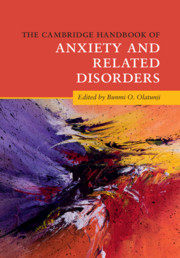Book contents
- The Cambridge Handbook of Anxiety and Related Disorders
- The Cambridge Handbook of Anxiety and Related Disorders
- Copyright page
- Dedication
- Contents
- Contributors
- Anxiety and Related Disorders
- Section 1 Basic Mechanisms in Fear and Anxiety
- Section 2 Transdiagnostic Processes
- Section 3 Assessment, Diagnosis, and Cultural Manifestations of Anxiety and Related Disorders
- Section 4 Etiology and Phenomenology of Specific Anxiety Disorders
- 15 Specific Phobia
- 16 Panic Disorder and Agoraphobia
- 17 Social Anxiety Disorder
- 18 Generalized Anxiety Disorder
- 19 Separation Anxiety Disorder
- 20 Selective Mutism
- Section 5 Etiology and Phenomenology of Specific OCD Spectrum Disorders
- Section 6 Etiology and Phenomenology of Specific Trauma- and Stressor-Related Disorders
- Section 7 Treatment and Prevention of Anxiety and Related Disorders
- Index
- References
15 - Specific Phobia
from Section 4 - Etiology and Phenomenology of Specific Anxiety Disorders
Published online by Cambridge University Press: 28 December 2018
- The Cambridge Handbook of Anxiety and Related Disorders
- The Cambridge Handbook of Anxiety and Related Disorders
- Copyright page
- Dedication
- Contents
- Contributors
- Anxiety and Related Disorders
- Section 1 Basic Mechanisms in Fear and Anxiety
- Section 2 Transdiagnostic Processes
- Section 3 Assessment, Diagnosis, and Cultural Manifestations of Anxiety and Related Disorders
- Section 4 Etiology and Phenomenology of Specific Anxiety Disorders
- 15 Specific Phobia
- 16 Panic Disorder and Agoraphobia
- 17 Social Anxiety Disorder
- 18 Generalized Anxiety Disorder
- 19 Separation Anxiety Disorder
- 20 Selective Mutism
- Section 5 Etiology and Phenomenology of Specific OCD Spectrum Disorders
- Section 6 Etiology and Phenomenology of Specific Trauma- and Stressor-Related Disorders
- Section 7 Treatment and Prevention of Anxiety and Related Disorders
- Index
- References
- Type
- Chapter
- Information
- The Cambridge Handbook of Anxiety and Related Disorders , pp. 421 - 450Publisher: Cambridge University PressPrint publication year: 2019



